Abstract
Infections of dicotyledonous plants by Agrobacterium tumefaciens result in the formation of crown gall tumors. Attachment of the bacteria to plant host cells is required for tumor formation. Human vitronectin and antivitronectin antibodies both inhibited the binding of A. tumefaciens to carrot cells. Wild-type bacteria are able to bind radioactive vitronectin; nonattaching mutants showed a reduction in the ability to bind vitronectin. The binding of biotype 1 A. tumefaciens to carrot cells or to radioactive vitronectin was not affected by high ionic strength. Detergent extraction of carrot cells removed the receptor to which the bacteria bind. The extract was found to contain a vitronectin-like protein. These results suggest that A. tumefaciens utilizes a vitronectin-like protein on the plant cell surface as the receptor for its initial attachment to host cells.
Full text
PDF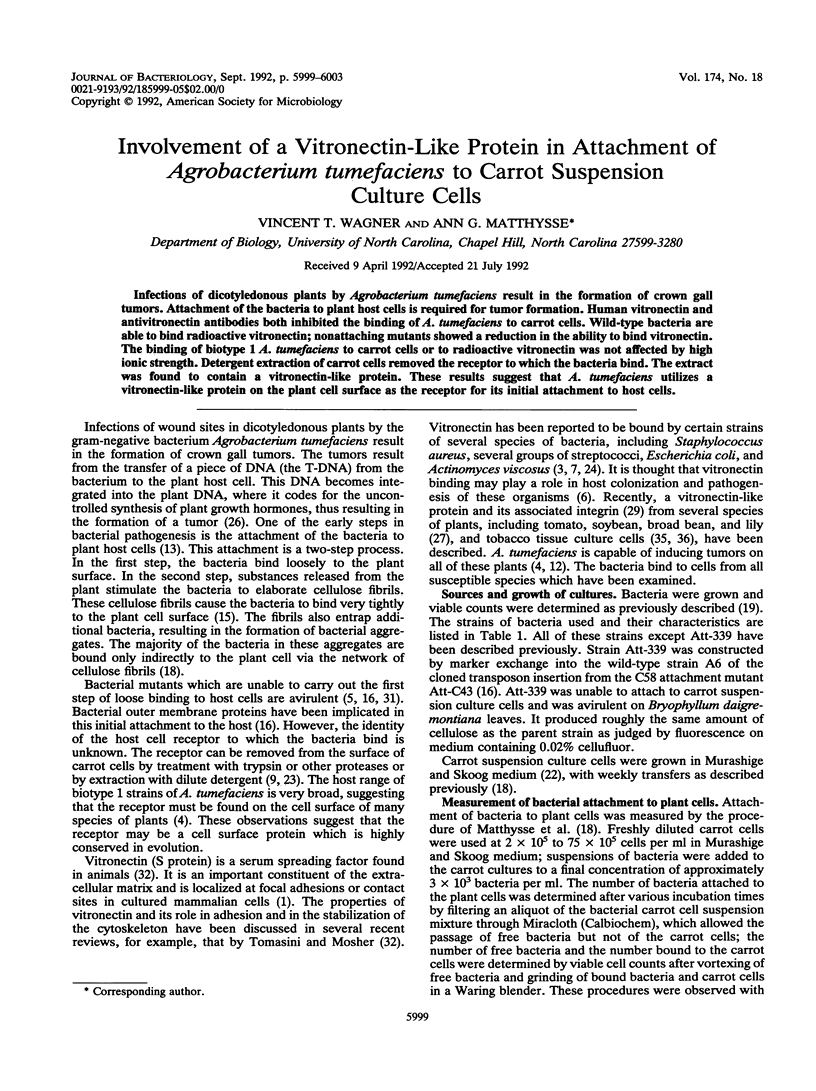
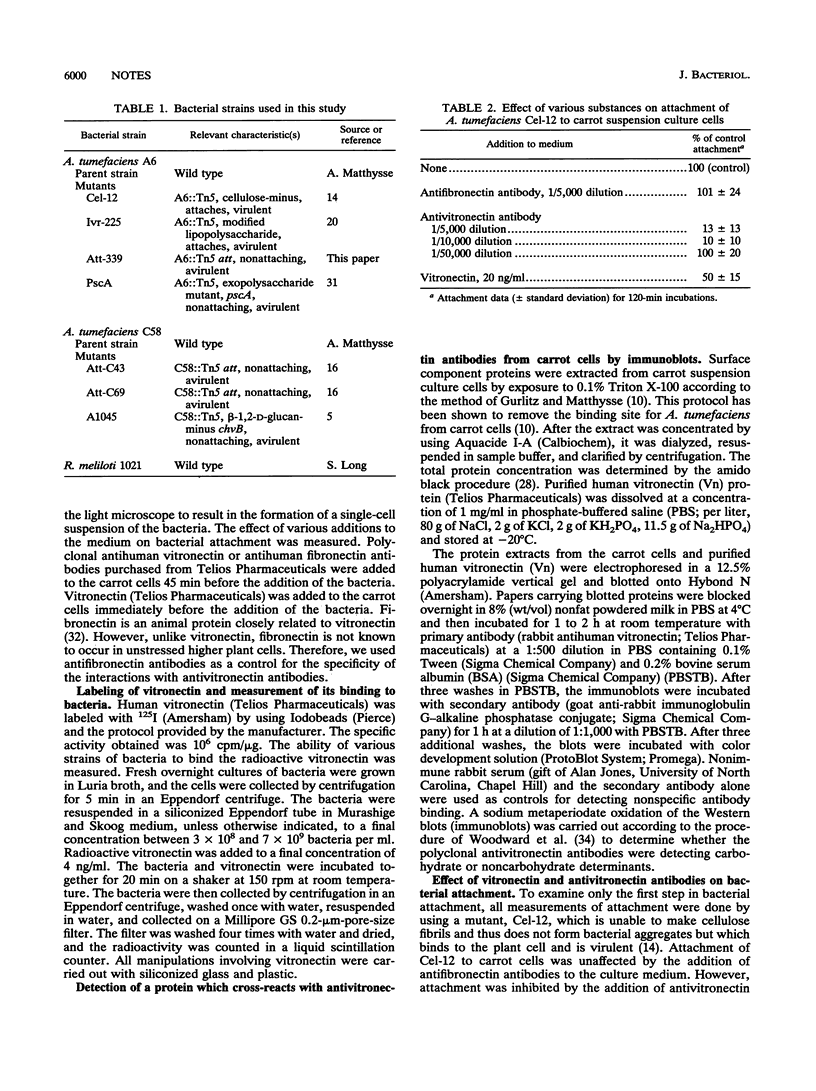
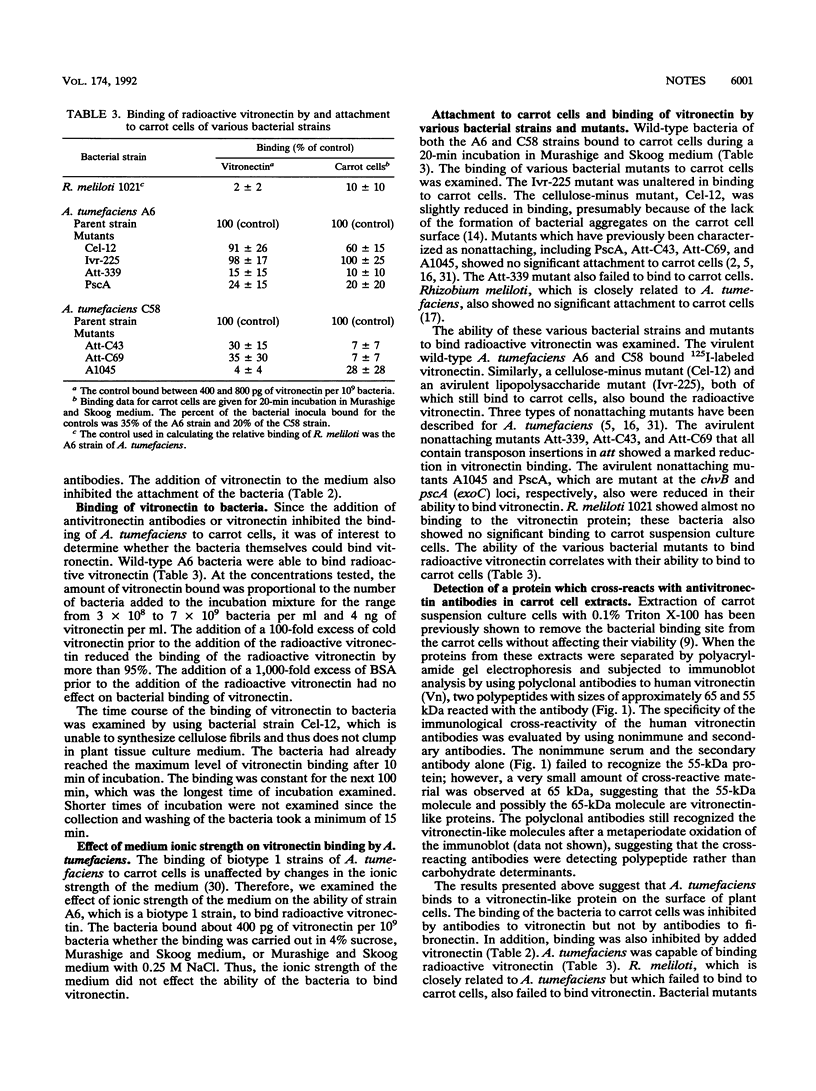
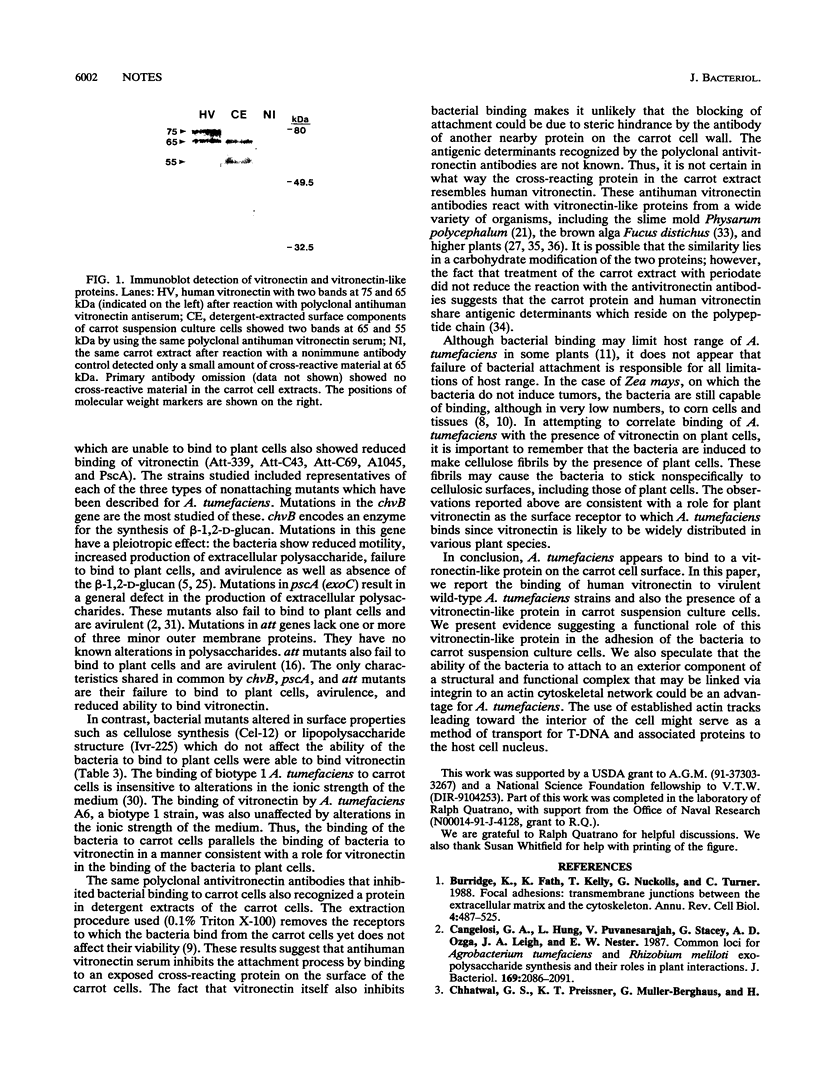
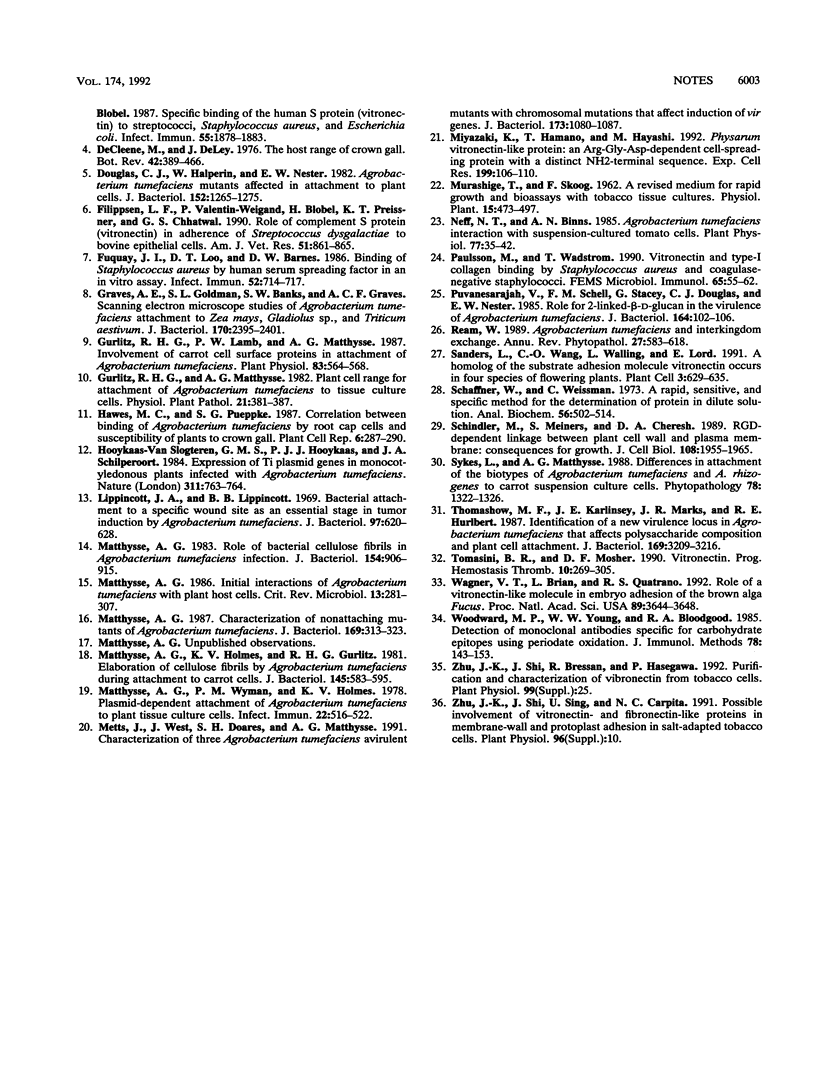
Images in this article
Selected References
These references are in PubMed. This may not be the complete list of references from this article.
- Burridge K., Fath K., Kelly T., Nuckolls G., Turner C. Focal adhesions: transmembrane junctions between the extracellular matrix and the cytoskeleton. Annu Rev Cell Biol. 1988;4:487–525. doi: 10.1146/annurev.cb.04.110188.002415. [DOI] [PubMed] [Google Scholar]
- Cangelosi G. A., Hung L., Puvanesarajah V., Stacey G., Ozga D. A., Leigh J. A., Nester E. W. Common loci for Agrobacterium tumefaciens and Rhizobium meliloti exopolysaccharide synthesis and their roles in plant interactions. J Bacteriol. 1987 May;169(5):2086–2091. doi: 10.1128/jb.169.5.2086-2091.1987. [DOI] [PMC free article] [PubMed] [Google Scholar]
- Chhatwal G. S., Preissner K. T., Müller-Berghaus G., Blobel H. Specific binding of the human S protein (vitronectin) to streptococci, Staphylococcus aureus, and Escherichia coli. Infect Immun. 1987 Aug;55(8):1878–1883. doi: 10.1128/iai.55.8.1878-1883.1987. [DOI] [PMC free article] [PubMed] [Google Scholar]
- Douglas C. J., Halperin W., Nester E. W. Agrobacterium tumefaciens mutants affected in attachment to plant cells. J Bacteriol. 1982 Dec;152(3):1265–1275. doi: 10.1128/jb.152.3.1265-1275.1982. [DOI] [PMC free article] [PubMed] [Google Scholar]
- Filippsen L. F., Valentin-Weigand P., Blobel H., Preissner K. T., Chhatwal G. S. Role of complement S protein (vitronectin) in adherence of Streptococcus dysgalactiae to bovine epithelial cells. Am J Vet Res. 1990 Jun;51(6):861–865. [PubMed] [Google Scholar]
- Fuquay J. I., Loo D. T., Barnes D. W. Binding of Staphylococcus aureus by human serum spreading factor in an in vitro assay. Infect Immun. 1986 Jun;52(3):714–717. doi: 10.1128/iai.52.3.714-717.1986. [DOI] [PMC free article] [PubMed] [Google Scholar]
- Gurlitz R. H., Lamb P. W., Matthysse A. G. Involvement of Carrot Cell Surface Proteins in Attachment of Agrobacterium tumefaciens. Plant Physiol. 1987 Mar;83(3):564–568. doi: 10.1104/pp.83.3.564. [DOI] [PMC free article] [PubMed] [Google Scholar]
- Halkier B. A., Møller B. L. Involvement of Cytochrome P-450 in the Biosynthesis of Dhurrin in Sorghum bicolor (L.) Moench. Plant Physiol. 1991 May;96(1):10–17. doi: 10.1104/pp.96.1.10. [DOI] [PMC free article] [PubMed] [Google Scholar]
- Lippincott B. B., Lippincott J. A. Bacterial attachment to a specific wound site as an essential stage in tumor initiation by Agrobacterium tumefaciens. J Bacteriol. 1969 Feb;97(2):620–628. doi: 10.1128/jb.97.2.620-628.1969. [DOI] [PMC free article] [PubMed] [Google Scholar]
- Matthysse A. G. Characterization of nonattaching mutants of Agrobacterium tumefaciens. J Bacteriol. 1987 Jan;169(1):313–323. doi: 10.1128/jb.169.1.313-323.1987. [DOI] [PMC free article] [PubMed] [Google Scholar]
- Matthysse A. G., Holmes K. V., Gurlitz R. H. Elaboration of cellulose fibrils by Agrobacterium tumefaciens during attachment to carrot cells. J Bacteriol. 1981 Jan;145(1):583–595. doi: 10.1128/jb.145.1.583-595.1981. [DOI] [PMC free article] [PubMed] [Google Scholar]
- Matthysse A. G. Initial interactions of Agrobacterium tumefaciens with plant host cells. Crit Rev Microbiol. 1986;13(3):281–307. doi: 10.3109/10408418609108740. [DOI] [PubMed] [Google Scholar]
- Matthysse A. G. Role of bacterial cellulose fibrils in Agrobacterium tumefaciens infection. J Bacteriol. 1983 May;154(2):906–915. doi: 10.1128/jb.154.2.906-915.1983. [DOI] [PMC free article] [PubMed] [Google Scholar]
- Matthysse A. G., Wyman P. M., Holmes K. V. Plasmid-dependent attachment of Agrobacterium tumefaciens to plant tissue culture cells. Infect Immun. 1978 Nov;22(2):516–522. doi: 10.1128/iai.22.2.516-522.1978. [DOI] [PMC free article] [PubMed] [Google Scholar]
- Metts J., West J., Doares S. H., Matthysse A. G. Characterization of three Agrobacterium tumefaciens avirulent mutants with chromosomal mutations that affect induction of vir genes. J Bacteriol. 1991 Feb;173(3):1080–1087. doi: 10.1128/jb.173.3.1080-1087.1991. [DOI] [PMC free article] [PubMed] [Google Scholar]
- Miyazaki K., Hamano T., Hayashi M. Physarum vitronectin-like protein: an Arg-Gly-Asp-dependent cell-spreading protein with a distinct NH2-terminal sequence. Exp Cell Res. 1992 Mar;199(1):106–110. doi: 10.1016/0014-4827(92)90467-m. [DOI] [PubMed] [Google Scholar]
- Neff N. T., Binns A. N. Agrobacterium tumefaciens Interaction with Suspension-Cultured Tomato Cells. Plant Physiol. 1985 Jan;77(1):35–42. doi: 10.1104/pp.77.1.35. [DOI] [PMC free article] [PubMed] [Google Scholar]
- Paulsson M., Wadström T. Vitronectin and type-I collagen binding by Staphylococcus aureus and coagulase-negative staphylococci. FEMS Microbiol Immunol. 1990 May;2(1):55–62. doi: 10.1111/j.1574-6968.1990.tb03479.x. [DOI] [PubMed] [Google Scholar]
- Puvanesarajah V., Schell F. M., Stacey G., Douglas C. J., Nester E. W. Role for 2-linked-beta-D-glucan in the virulence of Agrobacterium tumefaciens. J Bacteriol. 1985 Oct;164(1):102–106. doi: 10.1128/jb.164.1.102-106.1985. [DOI] [PMC free article] [PubMed] [Google Scholar]
- Sanders L. C., Wang C. S., Walling L. L., Lord E. M. A Homolog of the Substrate Adhesion Molecule Vitronectin Occurs in Four Species of Flowering Plants. Plant Cell. 1991 Jun;3(6):629–635. doi: 10.1105/tpc.3.6.629. [DOI] [PMC free article] [PubMed] [Google Scholar]
- Schaffner W., Weissmann C. A rapid, sensitive, and specific method for the determination of protein in dilute solution. Anal Biochem. 1973 Dec;56(2):502–514. doi: 10.1016/0003-2697(73)90217-0. [DOI] [PubMed] [Google Scholar]
- Schindler M., Meiners S., Cheresh D. A. RGD-dependent linkage between plant cell wall and plasma membrane: consequences for growth. J Cell Biol. 1989 May;108(5):1955–1965. doi: 10.1083/jcb.108.5.1955. [DOI] [PMC free article] [PubMed] [Google Scholar]
- Thomashow M. F., Karlinsey J. E., Marks J. R., Hurlbert R. E. Identification of a new virulence locus in Agrobacterium tumefaciens that affects polysaccharide composition and plant cell attachment. J Bacteriol. 1987 Jul;169(7):3209–3216. doi: 10.1128/jb.169.7.3209-3216.1987. [DOI] [PMC free article] [PubMed] [Google Scholar]
- Tomasini B. R., Mosher D. F. Vitronectin. Prog Hemost Thromb. 1991;10:269–305. [PubMed] [Google Scholar]
- Wagner V. T., Brian L., Quatrano R. S. Role of a vitronectin-like molecule in embryo adhesion of the brown alga Fucus. Proc Natl Acad Sci U S A. 1992 Apr 15;89(8):3644–3648. doi: 10.1073/pnas.89.8.3644. [DOI] [PMC free article] [PubMed] [Google Scholar]
- Woodward M. P., Young W. W., Jr, Bloodgood R. A. Detection of monoclonal antibodies specific for carbohydrate epitopes using periodate oxidation. J Immunol Methods. 1985 Apr 8;78(1):143–153. doi: 10.1016/0022-1759(85)90337-0. [DOI] [PubMed] [Google Scholar]



